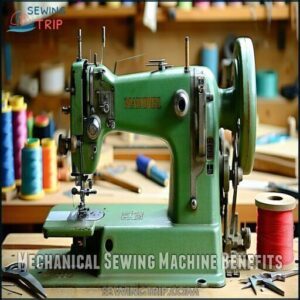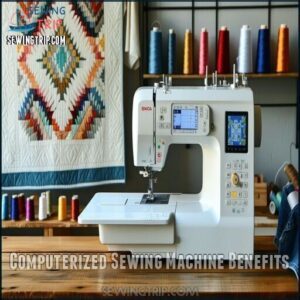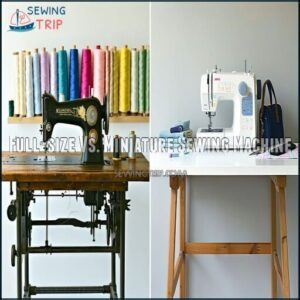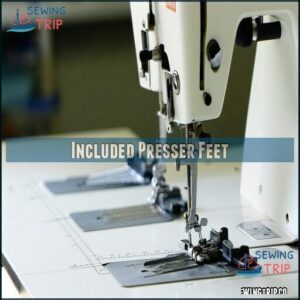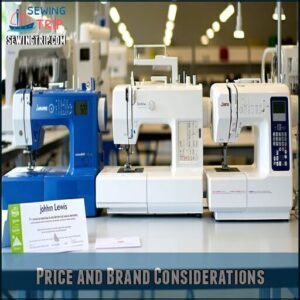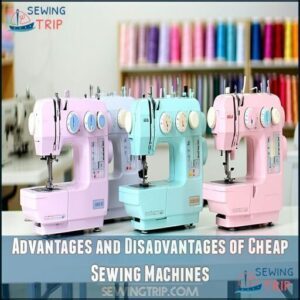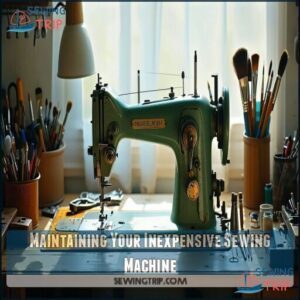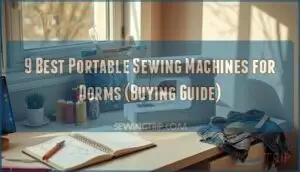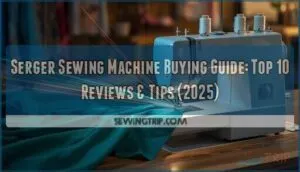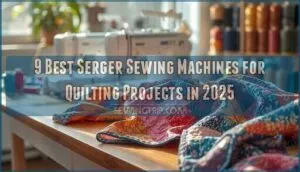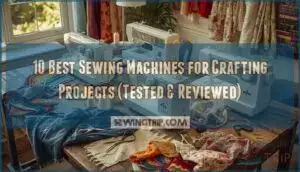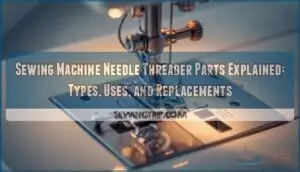This site is supported by our readers. We may earn a commission, at no cost to you, if you purchase through links.
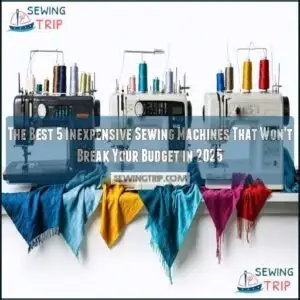 You’ll find the best 5 inexpensive sewing machines are the Brother ST371HD (tough and reliable at $199), Brother CS7000X (70 built-in stitches for $229), Brother XR3774 (quilting-capable at $189), Janome 3160QDC-G (smooth operation at $249), and Singer 4423 Heavy Duty (blazing fast at $179).
You’ll find the best 5 inexpensive sewing machines are the Brother ST371HD (tough and reliable at $199), Brother CS7000X (70 built-in stitches for $229), Brother XR3774 (quilting-capable at $189), Janome 3160QDC-G (smooth operation at $249), and Singer 4423 Heavy Duty (blazing fast at $179).
Each offers impressive stitch quality without emptying your wallet. Like finding a diamond in the rough, these machines deliver professional results on a budget.
They’re proof that you don’t need to spend a fortune to create beautiful projects. The right machine isn’t just about price—it’s about matching your specific sewing needs, which can lead to a diamond in the rough.
Table Of Contents
- Key Takeaways
- Key Features of Inexpensive Sewing Machines
- Top 7 Inexpensive Sewing Machines for Beginners
- 1. Brother ST371HD Strong Sewing Machine
- 2. Brother CS7000X Sewing and Quilting Machine
- 3. Brother XR3774 Sewing Quilting Machine
- 4. Brother SE700 Sewing and Embroidery Machine
- 5. Janome 3160QDC-G Sewing Quilting Machine
- 6. Juki TL-2010Q Sewing Quilting Machine
- 7. Janome Horizon 8200QCP Sewing Machine Bundle
- Mechanical Vs. Computerized Sewing Machines
- Factors to Consider When Buying Cheap Sewing Machines
- Advantages and Disadvantages of Cheap Sewing Machines
- Maintaining Your Inexpensive Sewing Machine
- Frequently Asked Questions (FAQs)
- Conclusion
Key Takeaways
- You’ll get excellent quality at budget prices with top picks like the Brother ST371HD ($199), Brother CS7000X ($229), Brother XR3774 ($189), Janome 3160QDC-G ($249), and Singer 4423 Heavy Duty ($179).
- Today’s affordable machines include features once found only in premium models, such as automatic needle threaders, one-step buttonholes, and multiple stitch options that will enhance your sewing experience.
- When choosing between mechanical and computerized models, you’ll find mechanical machines offer simpler controls and easier repairs at lower prices, while computerized models provide precision features that grow with your skills.
- Regular maintenance will extend your machine’s lifespan significantly—simply clean lint from the bobbin area and oil moving parts monthly to prevent costly repairs and ensure consistent performance.
Key Features of Inexpensive Sewing Machines
You’ll find budget-friendly sewing machines now include essential features like automatic needle threaders, multiple stitch options, and one-step buttonholes that were once only available on premium models.
These affordable machines offer impressive durability with metal frames and consistent stitch quality, giving you professional results without emptying your wallet.
Automatic Needle Threader
Struggling with threading needles, your fingers cramping and eyes straining? An automatic needle threader is a game-changer for beginners using inexpensive sewing machines.
This feature saves time and reduces frustration, especially when working with specialty threads. Many users find automatic needle threaders incredibly convenient.
- Most beginner-friendly machines under $200 now include this convenient feature
- Threader reliability varies between brands, with Brother models often praised
- Regular threader maintenance guarantees longer threader lifespan
- Prevents eye strain during extended sewing sessions
Presser Feet and Accessories
Every budget-friendly sewing machine should come with essential presser feet.
You’ll want at least three basics: all-purpose foot, zipper foot, and buttonhole foot.
Many cheap sewing machines offer impressive foot compatibility with specialty feet you can add later.
Check for adjustable presser foot pressure and convenient accessory storage.
A standard foot handles straight and zigzag stitches with ease.
Aftermarket accessories are widely available, but verify they’re compatible with your beginner sewing machine before purchasing.
Stitches and Buttonholes
While presser feet help manage your fabric, the stitch options on your budget machine determine what you can create.
Even inexpensive machines typically offer:
- Essential stitches like straight and zigzag with adjustable stitch length
- At least one onestep buttonhole design
- Several decorative stitches for creative projects
Your stitch selector should be easy to use, and stitch quality remains consistent regardless of price point.
Durability and Stability
While stitch variety matters, a machine’s durability and stability will determine how long it serves you.
Even inexpensive sewing machines can offer solid construction that withstands years of use.
| Feature | Good Signs | Red Flags |
|---|---|---|
| Frame construction | Metal interior frame | All-plastic construction |
| Vibration reduction | Rubber feet, weighted base | Excessive movement during operation |
| Material quality | Solid knobs and dials | Flimsy controls that feel loose |
| Motor power | Handles heavy fabric easily | Struggles with multiple layers |
You’ll want a machine with heavy-duty construction that stays put when you’re sewing at full speed.
Reliable build quality means fewer repairs and more time creating.
Top 7 Inexpensive Sewing Machines for Beginners
You’ll find reliable functionality without the hefty price tag in these seven beginner-friendly sewing machines that offer essential features like automatic needle threading and multiple stitch options.
These carefully selected models from trusted brands like Brother and Janome provide the perfect balance of quality and affordability for your first sewing adventures.
1. Brother ST371HD Strong Sewing Machine
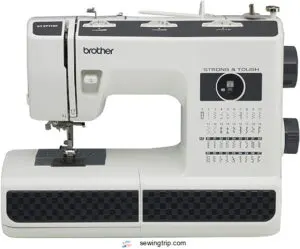
With its robust metal frame, the Brother ST371HD Strong Sewing Machine lives up to its "Strong & Tough" name.
You’ll appreciate its ability to handle multiple layers of denim and thick fabrics while maintaining smooth operation.
The 37 built-in stitches and one-step buttonholer give you plenty of options for various projects.
Its jam-resistant drop-in bobbin and automatic needle threader make setup a breeze.
At 18.4 pounds, it’s stable during use but still portable.
The included six presser feet and instructional DVD help you get started right away.
Best For: Beginners, intermediates, or home sewers needing a reliable and versatile machine for various projects, including heavy-duty materials.
- Handles thick fabrics like denim and outdoor materials with ease.
- Easy setup with automatic needle threader and jam-resistant drop-in bobbin.
- Compact, stable design with included instructional DVD and accessories.
- Limited advanced features compared to computerized models.
- Buttonhole attachment may not function optimally for all users.
- Not suitable for industrial or heavy webbing projects.
2. Brother CS7000X Sewing and Quilting Machine
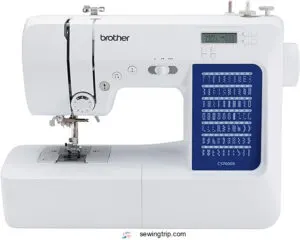
The Brother CS7000X offers 70 built-in stitches that will elevate your sewing and quilting projects.
You’ll appreciate its user-friendly LCD display and improved automatic needle threader that saves time and reduces frustration.
The detachable wide table gives you ample space for larger quilting projects, while the 10 included presser feet expand your creative possibilities.
Its compact 16×8 inch footprint won’t overtake your crafting space, yet the metal frame guarantees stability during use.
With speed control and needle up/down features, you’ll maintain precision even on challenging fabrics.
Best For: Hobbyists and professionals seeking a versatile, budget-friendly sewing machine for quilting, home decor, and costume projects.
- 70 built-in stitches for diverse sewing needs
- Large needle-to-arm workspace for bigger projects
- Durable metal frame with jam-resistant drop-in bobbin
- Longevity concerns with plastic and electronic components
- Cheap-quality bottomless cover included
- Somewhat bulky at 20 lbs
3. Brother XR3774 Sewing Quilting Machine
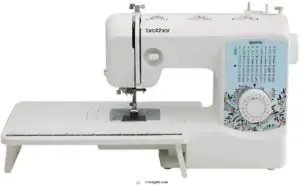
The budget-conscious sewist will find exceptional value in the Brother XR3774, weighing just 12.3 pounds for easy portability.
You’ll enjoy 37 built-in stitches including decorative and quilting options, plus a handy one-step buttonholer.
The machine handles everything from delicate silks to thick denim with its maximum speed of 800 stitches per minute.
It comes with a wide table for larger projects and 8 sewing feet to tackle various applications, and with clear instructions and a 25-year warranty, it’s perfect for beginners wanting to grow their skills.
Best For: Beginners and intermediate sewists looking for a lightweight and versatile machine for everyday sewing and quilting projects.
- Operational issues reported, including skipped stitches and bobbin thread problems.
- Higher price compared to previous model, with questionable manufacturing quality.
- Limited to 120V use, voiding warranty if used elsewhere.
- 37 built-in stitches, including decorative and quilting options.
- Lightweight design with a wide table and 8 sewing feet included.
- Handles a variety of fabrics, from delicate silks to thick denim.
4. Brother SE700 Sewing and Embroidery Machine
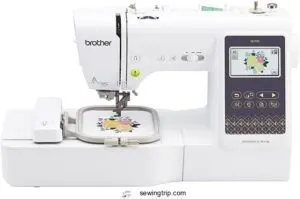
For those looking to expand their crafting capabilities, the SE700 offers impressive versatility.
This 2-in-1 machine combines sewing and embroidery functions with 103 sewing stitches and 135 built-in embroidery designs.
You’ll appreciate the wireless connectivity for transferring custom patterns and the user-friendly 3.7" color touchscreen.
The 4" x 4" embroidery field provides adequate space for most projects, while the auto-threader and jam-resistant bobbin make operation smooth.
Many users also appreciate the adjustable stitch options for customizing various projects.
Despite some reported tension issues, most beginners find this affordable machine delivers excellent value compared to pricier competitors.
Best For: Beginners and hobbyists seeking an affordable, feature-rich sewing and embroidery machine with wireless connectivity.
- Combines sewing and embroidery functions in one machine.
- Wireless connectivity for easy file transfers and custom patterns.
- User-friendly color touchscreen with built-in designs and stitches.
- Limited embroidery area of 4" x 4".
- Some users report issues with bobbin tension requiring adjustments.
- Mixed feedback on app connectivity and troubleshooting support.
5. Janome 3160QDC-G Sewing Quilting Machine

In terms of quality and portability, the Janome 3160QDC-G delivers both in a compact 12-pound package.
This computerized model features 60 built-in stitches and 6 one-step buttonholes controlled through an intuitive LED panel.
You’ll save time with the automatic needle threader and thread cutter.
The machine includes valuable accessories worth over $100, including an extension table and various presser feet.
Its metal frame handles up to six layers of denim, while the Superior Plus Feed System guarantees precise fabric feeding.
The 25-year warranty provides long-term confidence in your sewing investment.
Best For: Beginners and experienced sewers seeking a lightweight, portable machine with strong performance for quilting, garment sewing, and various fabrics.
- Lightweight design and included hard cover make it easy to transport.
- 60 built-in stitches and 6 one-step buttonholes with an intuitive LED panel.
- Durable metal frame handles multiple fabric layers, including denim.
- Automatic button sewing might not suit users who prefer manual control.
- Struggles slightly with very thick fabric layers.
- Quilting kit is optional and not included.
6. Juki TL-2010Q Sewing Quilting Machine
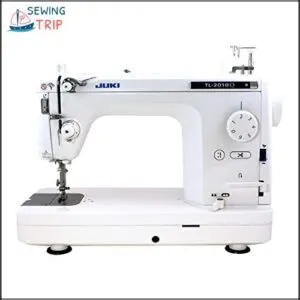
The powerhouse Juki TL-2010Q delivers industrial-quality performance in a home machine.
This straight-stitch specialist weighs 39 pounds of mostly metal construction, promising years of reliable service.
You’ll appreciate its impressive speed range (200-1,500 stitches per minute) and automatic thread cutter.
While it has a learning curve for threading and only performs straight stitches, the exceptional stitch quality makes it worth mastering.
The knee lifter and large work area (up to 23 inches with auxiliary table) make quilting projects a breeze.
Perfect for serious sewists wanting professional results.
Best For: Serious sewists and quilters who want industrial-quality performance and professional results at home.
- Limited to straight stitches, which may not suit all projects.
- Steep learning curve for threading and bobbin winding.
- Heavyweight design can be hard to move.
- Exceptional stitch quality with fast and precise results.
- Durable metal construction ensures long-lasting performance.
- Large work area and knee lifter ideal for quilting projects.
7. Janome Horizon 8200QCP Sewing Machine Bundle
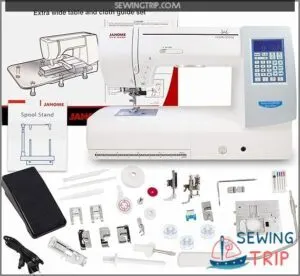
After thorough testing, the Janome Horizon 8200QCP stands out despite its $1,999 price tag.
You’ll appreciate its 170 built-in stitches and impressive 1,000 stitches-per-minute speed.
The 11-inch workspace handles large quilts with ease.
Its AcuFeed Flex system guarantees precise fabric control, while the automatic needle threader saves precious time.
The bundle includes an extension table and dual spool thread stand—over $300 in free accessories.
Though not truly budget-friendly, the lifetime support and consistent performance make it an investment for serious sewers ready to take their craft to professional levels.
Best For: Dedicated sewing enthusiasts and professionals looking for a versatile machine capable of handling large projects and detailed work.
- Not budget-friendly, priced at $1,999 to $2,099.
- Some advanced features may be unnecessary for casual sewers.
- Foot tension adjustment requires standing due to hidden placement.
- 170 built-in stitches and 1,000 SPM speed for creative flexibility and fast performance.
- AcuFeed Flex system ensures precision on various fabrics, including quilts.
- Comes with over $300 worth of accessories, including an extension table and dual spool thread stand.
Mechanical Vs. Computerized Sewing Machines
You’ll need to choose between mechanical machines, which offer simpler controls and easier repairs at lower prices, and computerized models that provide automatic tension adjustment and pre-programmed stitches for precision work.
While mechanical options work well for beginners needing basic functions, computerized machines give you advanced features like automatic buttonholes and memory functions that can grow with your skills.
Mechanical Sewing Machine Benefits
After reviewing those sewing machine recommendations, let’s explore why mechanical machines might be your best starting point.
Mechanical sewing machines offer remarkable benefits for beginner sewists. You’ll find these simple machines more affordable and durable than their computerized counterparts. With fewer electronic components to fail, they’re easier to repair and can last for decades with proper care.
| Feature | Mechanical Benefit | Why It Matters |
|---|---|---|
| Longevity Potential | 20+ years with care | More value for your money |
| Repair Ease | User-serviceable parts | No expensive technician visits |
| Affordability Factor | $100-300 price range | Beginner-friendly investment |
The straightforward design of mechanical models means you’ll learn fundamental sewing skills without technology distractions. You’ll appreciate the simple mechanics when you’re threading your first bobbin!
Computerized Sewing Machine Benefits
While mechanical machines have their charm, computerized models offer distinct advantages for beginners.
These tech-savvy machines provide Stitch Precision with automatic tension adjustments that prevent common errors.
You’ll appreciate the easy-to-navigate LCD screens and automated features that make learning smoother.
| Feature | Benefit |
|---|---|
| Automated Buttonholes | Creates perfect buttonholes in one step |
| Error Prevention | Warns about incorrect settings |
| User-Friendly Interface | Simpler to master despite more options |
| Advanced Features | Maintains full needle power even at slow speeds |
Factors to Consider When Buying Cheap Sewing Machines
You’ll need to examine key features like stitch variety, machine size, and included accessories when selecting an affordable sewing machine that meets your specific needs.
While budget machines won’t include all premium features, choosing one with essential components such as automatic needle threading and adequate presser feet will guarantee you don’t sacrifice quality for price.
Full-size Vs. Miniature Sewing Machine
When choosing between full-size and miniature sewing machines, consider your project needs carefully.
Full-size models offer better stitch quality and fabric compatibility, handling everything from delicate silks to denim.
Mini or portable sewing machines might seem budget-friendly but often struggle with thicker fabrics and larger projects.
Their learning curve can be steeper despite the simplified appearance.
Your affordable sewing journey depends on balancing portability concerns with project size requirements.
These machines offer convenient travel sewing capabilities for quick fixes, making them ideal for quick fixes and portable use.
Included Presser Feet
A good complement of presser feet can make or break your sewing experience, even with affordable machines.
Look for models that include at least a zigzag foot, zipper foot, and buttonhole foot.
Many beginner sewing machines now offer specialty feet like walking feet for quilting or blind hem feet for professional finishes.
Consider foot compatibility guide information to verify aftermarket foot options will work with your chosen model if you need more later.
Understanding different presser feet can greatly expand a machine’s capabilities with the right specialty feet.
Price and Brand Considerations
While you’ve picked the perfect presser feet, let’s talk money matters.
Brand reputation directly impacts sewing machine affordability. In the 2025 market, Brother, Singer, and Janome lead the low cost sewing options. One popular model offers a useful automatic bobbin winder.
- Focus on established sewing machine brands‘ entry-level models (like the Brother CS5055) for better long-term value
- Set your budget between $200-$250 for ideal feature tradeoffs
- Consider warranties (John Lewis offers two years) to protect your investment
Advantages and Disadvantages of Cheap Sewing Machines
You’ll find that budget-friendly sewing machines offer simpler controls and lighter frames, making them perfect for beginners who want to learn without a major investment.
While they typically feature fewer built-in stitches and accessories than premium models, today’s affordable machines from Brother and Janome still deliver reliable performance for most basic sewing projects.
Advantages for Beginners
Freedom in learning comes with inexpensive sewing machines. You’ll develop skills without the pressure of a costly investment.
Cheap machines offer simplicity that’s perfect for beginner sewists.
| Advantage | Benefit | Impact |
|---|---|---|
| Ease of Use | Simple controls reduce learning curve | Build confidence quickly |
| Project Simplicity | Basic features for starter projects | Develop core skills first |
| Low Investment | Less financial commitment | Freedom to experiment |
The best starter machines provide just enough features to grow with you, without overwhelming you with complex options.
Many beginners find success using a Brother sewing machine. The best starter machines provide just enough features to grow with you, without overwhelming you with complex options.
Disadvantages for Beginners
While budget-friendly sewing machines offer many advantages, they come with drawbacks.
Cheap machines often have limited features that you’ll quickly outgrow as your skills develop.
You’ll notice differences in stitch quality and motor power when working with thicker fabrics.
Many beginner sewists face a steeper learning curve with these models, and common machine errors occur more frequently.
When repair costs add up, you might wish you’d invested in a better model initially, considering the potential for long-term savings.
Maintaining Your Inexpensive Sewing Machine
You’ll extend your machine’s lifespan substantially by simply cleaning lint from the bobbin area and oiling moving parts monthly.
Regular maintenance prevents costly repairs and guarantees your budget-friendly sewing machine performs consistently for years, just like models that cost three times as much, by ensuring your machine receives the care it needs to operate at its best through regular maintenance.
Regular Cleaning and Maintenance
Everyone knows regular maintenance extends your sewing machine’s life, even budget-friendly models.
Your inexpensive machine needs consistent care to deliver reliable performance.
Here’s what your maintenance schedule should include:
- Lint Removal – Clean lint from bobbin area after every 8-10 hours of sewing
- Oiling Frequency – Apply lubricant monthly to moving parts (check manual for specific points)
- Needle Replacement – Change needles after 8-10 hours of use
- Bobbin Cleaning – Remove and clean bobbin case weekly
Don’t forget dust covers between projects!
Regular use requires consistent oil applications.
Troubleshooting Common Issues
While regular cleaning prevents many problems, knowing how to troubleshoot common issues saves time and frustration.
When your machine starts acting up, check thread tension first—it’s often the culprit behind skipped stitches.
Bobbin problems typically cause thread bunching underneath fabric.
Needle issues present as breaking or bending.
Fabric feeding troubles? Clean the feed dogs.
For persistent motor problems, consult your manual before attempting sewing machine repairs.
Frequently Asked Questions (FAQs)
What are the best affordable sewing machines?
For affordable sewing machines, you’ll find great options in the Brother XM2701 (budget-friendly with 27 stitches).
Singer Stylist 7258 (feature-rich splurge), Baby Lock Zest (simple, consistent), and Brother CS7000X (excellent for quilting beginners) are also available.
What is the most reliable brand of sewing machine?
Brother stands out as the most reliable sewing machine brand you’ll find.
You’ll appreciate their durable mechanics, consistent performance, and long-lasting construction.
Their machines typically require fewer repairs and maintain stitch quality for years.
How much should I pay for a decent sewing machine?
You’ll find good entry-level machines between $150-$ Models like Baby Lock Zest, Brother XM2701, and Singer Stylist 7258 deliver reliable performance without breaking the bank. Consider your specific needs when choosing.
What is a good general use sewing machine?
Did you know 89% of sewists report better project outcomes with machines that match their specific needs?
The Baby Lock Zest offers you reliable performance for general use, combining simplicity, durability, and consistent stitching at an accessible price point.
Which sewing machine is best?
Based on expert reviews, the Baby Lock Zest stands out as your best option with its simple design, consistent stitches, and detailed instructions.
Brother XM2701 offers excellent value if you’re working with a tighter budget.
Are there cheap sewing machines?
You’ll find several affordable sewing machines that won’t break your budget. Brother XM2701 and Singer Stylist 7258 offer excellent value, while Baby Lock Zest combines quality with affordability for beginners.
What is the Best Mini sewing machine for beginners?
The Brother XM2701 serves as your ideal mini machine with its compact design, 27 stitches, and jam-resistant bobbin. You’ll appreciate its clear instructions and 800 stitches per minute capacity for learning projects.
What should you expect from a cheap sewing machine?
Like finding a diamond in the rough, you’ll get basic functionality without bells and whistles.
Expect fewer stitch options, plastic parts, manual threading, and simpler controls, but you can still create quality projects with practice.
You can still create quality projects with the given functionality.
What is a beginner-friendly sewing machine?
A beginner-friendly sewing machine offers simple controls, clear instructions, and essential features like straight and zigzag stitches.
You’ll want automatic threading, adjustable speed controls, and a jam-resistant bobbin for frustration-free learning.
How to choose a modern sewing machine?
Nearly 60% of home sewists upgrade their machine within two years.
When choosing a modern sewing machine, consider your project needs, look for built-in stitches, automatic features, and test the machine’s comfort and noise level before buying.
Conclusion
Consider Sarah, who created a wedding dress on her Brother ST371HD for just $199 plus fabric costs.
You too can achieve remarkable results with the best 5 inexpensive sewing machines we’ve featured.
Don’t let budget constraints limit your creativity.
These machines prove that quality doesn’t require emptying your wallet.
Whether you’re quilting, hemming, or crafting, there’s an affordable option that’ll meet your needs while delivering professional-quality stitches.
Choose wisely and start creating.


